What Causes Rust in Hot Tub: How Can You Prevent It?
Find out what causes Rust in a hot tub and how to prevent it. Learn about the common causes of Rust and how to protect your hot tub from further damage.
Rust in hot tubs is caused by water and oxygen, but other factors can accelerate the process, such as:
- Imbalanced water chemistry with exceptionally high pH levels.
- Excessive use of chemicals, such as chlorine or bromine.
- Damage to the hot tub’s surface, which exposes the metal to the elements.
- Galvanic corrosion occurs when two different metals come into contact with each other in an electrolyte solution, such as hot tub water.
To prevent rust in your hot tub, it is essential to maintain proper water chemistry, avoid using excessive chemicals, and repair any damage to the surface promptly. Consider using a rust inhibitor, which can help to protect metal parts from corrosion.
What Causes Rust in Hot Tubs
Rust is a common problem in hot tubs, and it can be caused by a variety of factors, including:
- Incorrect pH levels: The ideal pH level for hot tub water is between 7.2 and 7.8. If the pH is too low, the water will be acidic and more likely to cause rust. If the pH is too high, the water will be alkaline and can also cause rust, but to a lesser extent.
- High levels of metals in the water: Some metals, such as iron and copper, can react with the chemicals in hot tub water and cause rust. These metals can come from the hot tub itself, such as from metal fittings or jets, or they can come from the water source, such as from a well or old pipes.
- Lack of maintenance: Regular maintenance is essential for preventing rust in hot tubs. This includes testing the water chemistry regularly and adding chemicals as needed, as well as cleaning the hot tub and removing any debris or build-up.
How to Remove Rust from Hot Tub Water
If you have rust in your hot tub water, there are a few things you can do to remove it:
- Drain and refill the hot tub: This is the most effective way to remove rust from hot tub water. Be sure to clean the hot tub thoroughly before refilling it.
- Use a rust remover: There are a number of commercial rust removers available for hot tubs. Be sure to follow the instructions on the product label carefully.
- Use ascorbic acid (vitamin C): Ascorbic acid can also be used to remove rust from hot tub water. Add 1 cup of ascorbic acid powder to the hot tub water and circulate it for at least 2 hours.
How to Prevent Rust in Hot Tubs
The best way to prevent rust in hot tubs is to maintain the water chemistry properly and to clean the hot tub regularly. Here are some specific tips:
- Test the water chemistry regularly and add chemicals as needed. The ideal pH level for hot tub water is between 7.2 and 7.8. You should also test the alkalinity and hardness of the water and adjust them as needed.
- Clean the hot tub regularly. Remove any debris or build-up from the hot tub, including from the jets, filters, and skimmer basket.
- Use a rust inhibitor. There are a number of commercial rust inhibitors available for hot tubs. Adding a rust inhibitor to the water can help to prevent rust from forming.
- Rust spots in hot tub: Rust spots in hot tubs can be caused by the same factors that cause rust in hot tub water. To remove rust spots, you can use a commercial rust remover or a mixture of ascorbic acid and water.
- Spa rust: Spa rust is the same as hot tub rust. The same causes and prevention methods apply.
- How to remove stuck hot tub filter: If your hot tub filter is stuck, you can try the following:
- Turn off the hot tub and disconnect it from the power source.
- Remove the filter cap or housing.
- Apply a lubricant, such as WD-40, to the filter gasket.
- Use a rubber strap or wrench to loosen the filter.
- Once the filter is loose, you can remove it by hand.
- Can I use the tub with rust flakes: It is not recommended to use a hot tub with rust flakes in the water. Rust flakes can damage the hot tub and can also irritate your skin.
- Yellow stains on inflatable hot tub: Yellow stains on inflatable hot tubs can be caused by a variety of factors, including sunscreen, body oils, and minerals in the water. To remove yellow stains, you can use a mixture of baking soda and water or a commercial hot tub cleaner.
- Brown stains on inflatable hot tub: Brown stains on inflatable hot tubs can be caused by a variety of factors, including rust, dirt, and algae. To remove brown stains, you can use a mixture of vinegar and water or a commercial hot tub cleaner.
Rust in hot tubs refers to iron oxide (Fe2O3) particles or flakes in the water or on the tub’s surface. Rust is typically brown or red and can be unsightly and even hazardous to bathers.
The most common cause of Rust in hot tubs is the presence of iron in the water. Iron can come from healthy water, corroded plumbing, or iron-rich soil. When the water is heated, the iron particles can oxidize and form rust, which can settle on the tub’s surface or be suspended in the water.
Why Does Rust Form?
I was disappointed to find rust forming on my hot tub. Rust, or iron oxide, happens when the iron in the hot tub’s surface is exposed to oxygen and moisture. The heat and chemicals in hot tub water accelerate this process. Rust is not just an eyesore; it can damage the tub over time if left unchecked.
4 Reasons Your Hot Tub is Rusting (And How to Stop It)
1. Improper Water Chemistry
The #1 cause of rust is improper water chemistry. The chemicals that sanitize the water – chlorine and bromine – must be kept in the ideal range. Too little, and bacteria can grow. Too much and the chemicals attack the tub’s surface. Test and adjust the chemicals weekly to keep them balanced.
2. Low Water Levels
Keeping the water level high is crucial. When it drops too low, the metal components are exposed to air. It allows oxidation and rust to form above the water line. Check the water level often and top it off as needed.
3. Scratches and Damage
Scratches or cracks in the finish expose the bare metal underneath. It provides the perfect spot for rust to take hold. Avoid dragging equipment or toys across the bottom. Repair any deep gouges right away.
4. Age and Wear
Over time, the finish can break down from exposure to chemicals and minerals. Rust is expected along the seats and floor after 5-7 years as the undercoating peeks through. Consider a professional resurfacing to stop further rust.

5 TIPS TO KEEP YOUR HOT TUB FROM RUSTING
Keep it looking new and rust-free with these simple tips:
- Use a cover when the tub isn’t in use. This will keep the water clean and reduce the number of debris that can cause rusting.
- Inspect the seals around the cover’s edges to ensure they’re tight and not leaking. A leaky seal can let water seep into the tub, leading to rusting.
- Regularly clean the filters and keep the water circulating so it doesn’t stagnate. Stagnant water is more likely to cause rusting.
- Add a rust inhibitor to the water regularly. This will help protect against any surface corrosion.
- Remove any leaves or other debris that may fall into the tub, which can cause rusting problems.
CLEANING RUST FROM A HOT TUB
Here are some of the things you can do:
- If a lot of Rust is found, you must run the spa through an empty cycle with many bubbles. This will remove it and loosen up any debris stuck to your hot tub’s walls. This can help you to find where it is located.
- Another way to find the source is by getting a small piece of white vinyl from an old dryer. Use this to scrub off any rust you can remove from the walls and floor. You can also use a toothbrush to remove Rust stuck to the tub’s walls.
- If you find Rust on its floor, place a piece of cardboard under the tub to catch any water running from above. This will prevent small bits of Rust from falling into your tub.
- If you have access to a pressure washer, turn it on and spray the bottom of the tub with warm water. This will loosen up any debris stuck to the bottom of your tub.
- If you can access a vacuum, suck up any rust stuck to the bottom of your hot tub. You can also use a broom to sweep it up.
- If you can access a pool chemical, such as chlorine or chlorinator, add it to the water and let it sit for 24 hours. This will kill any rust that is stuck to your tub’s walls.
- If you can access a pool pump, plug it in and run it for 5 minutes. This will help clean out any rust stuck to your hot tub’s walls.
- Get out of your spa, open the cover, and let it sit for 24 hours.
How I Get Rid of Limescale in My Hot Tub
Dealt with limescale buildup in my hot tub before, and it’s no fun. Here are my go-to methods for tackling it:
- Use a Limescale Remover – Products like CL-17 or Lime-A-Way work wonders in breaking down mineral deposits. Follow the bottle instructions and let the remover sit before scrubbing and rinsing.
- Go Natural – I’ll fill a bucket with white vinegar and submerge stained areas overnight for a non-toxic option. The acid in the vinegar dissolves the limescale.
- Scrub with Care – If the limescale is stubborn, gentle scrubbing with a soft brush helps break it up. I’m careful not to damage my hot tub’s surface.
- Drain Frequently – To prevent future buildup, I make it a habit to drain and refill my hot tub regularly. It removes any minerals left behind by the water.
- Install a Filter – Using a water-softening filter helps reduce minerals in the water in the first place. Preventing limescale is more straightforward than removing it!
How I Get Rid of Rust Stains in My Fiberglass Hot Tub
- First, I try a mild acid – White vinegar or lemon juice often does the trick for light stains. I let it sit for a while before scrubbing.
- I break out the big guns for stubborn stains – Chemicals like CLR or muriatic acid are more potent and better at dissolving more severe discoloration. I’m cautious with these!
- I spot-test acids first – To ensure it doesn’t damage my hot tub’s surface, I test any acid on a small, inconspicuous area before applying it broadly.
- If acids don’t cut it, I gently sand – Lightly sanding with fine-grit sandpaper can remove tough stains. It’s a last resort since it scuffs the surface.
- I protect my hands! – I always wear gloves to keep my skin safe when dealing with strong chemicals. Rust stains aren’t worth getting burned.
- The final step is resealing – Once stains are removed, I reseal that area to protect the fiberglass and prevent future stains.
Why the Bottom of My Hot Tub Has Rust Stains
- No protective coating – If the metal isn’t appropriately sealed, rust can develop from exposure to water. Check for any breaches in the protective covering.
- Water sitting too long – Residual water can start corroding the metal if I don’t drain the tub fully after use. Regular draining is necessary.
- Chemical imbalance – Improperly balanced hot tub water can accelerate rusting. I’ll test and adjust alkalinity, pH, and sanitizer levels.
- Scratches and damage – Any scrapes or cracks in the protective coating expose the metal and allow rust. Inspect closely and reseal any compromised areas.
- Debris buildup – Leaves or other organic matter settling on the bottom can cause rust if not cleaned. Frequent skimming and filtering are critical.
- Age and wear – older tubs may have worn-down coatings that must be reapplied. A new, non-corrosive liner may be in order if it’s old.
WHAT’S CAUSING WATER HEATER TO RUST ON THE BOTTOM, AND HOW TO PREVENT IT?
To prevent rusting on the bottom of your water heater, you can take the following steps:
- Regularly flush your water heater to remove sediment buildup. This can be done by turning off the power to the unit, closing the water supply valve, and attaching a garden hose to the drain valve at the bottom of the tank. Open the valve and let the water drain out until it runs clear.
- Install a sediment filter on your incoming water supply line. This will help to trap sediment before it reaches your water heater.
- Consider installing a water softener if you have hard water. Hard water contains high levels of minerals that can contribute to sediment buildup and rusting.
- Inspect your water heater regularly for signs of Rust or corrosion. If you notice any damage, have it repaired as soon as possible to prevent further rusting?
By taking these steps, you can help prevent rusting on the bottom of your water heater and extend its lifespan.
IS RUST IN HOT WATER DANGEROUS?
It is a dangerous compound that can cause severe damage to both people and property. Ingesting Rust can cause nausea, vomiting, and diarrhea. Contacting with Rust can cause skin irritation, redness, and burning. It can also corrode metal, which can create a safety hazard.
BROWN SPOTS ON THE HOT TUB
A few things could cause brown spots on a hot tub. One possibility is that the water is not correctly chlorinated, which can cause algae to grow.
Another possibility is that something in the water is causing the spots, such as iron or copper. If you cannot determine the cause of the brown spots, it is best to contact a professional to help you troubleshoot the issue. Reading about error code in hot tubs Coleman SaluSpa E02 Code Error Fixing Guide.
Common Queries:
Q. How do I balance my water chemistry?
A. Balanced water chemistry is the key to preventing corrosion and keeping the pH level between 7.5 and 8 will help prevent it.
Q. How do I know if my hot tub is balanced?
A. The appearance of the water indicates balance. For example, your tub is balanced if there are no visible scale deposits, and the pH level is between 7.5 and 8.
Q. How do I clean my hot tub filter?
A. In the beginning, you must get rid of the heavy sediment. Then use a whole-house filter and weekly cleanings or a cartridge filter at least every two weeks.
Q. How often should I clean my hot tub?
A. You should clean the water every two weeks for hot tubs with a water capacity of 1000 gallons or less. You should clean the water every six months for hot tubs with over 1000 gallons.
Q. How do I clean my spa?
A. First, turn off the power to the spa. Then, drain and clean the filter.
Q. What should I do if my hot tub leaks?
A. First, turn off the power to the spa. Then, drain and clean the filter. If your hot tub leaks water, replace it as soon as possible.
Q. How do I save money on my hot tub?
A. If you live in an area with mild winters, you can cut your heating costs by shutting off the spa for a few weeks over the winter.
Q. How do you get rid of Rust in a hot tub?
A. You can try a “salt scrub” to remove the stains from the bottom of your hot tub.
Q. How much should I pay for a hot tub?
A. The cost of a hot tub depends on the brand and the type of spa you select.
Q. How can I keep my hot tub clean?
A. There are several ways to keep your hot tub clean. First, you should use a filter every week to prevent clogging.
Q. Why are my hot tub jets rusting?
A. When the hot tub’s rusting jets are used, they can cause a chemical reaction that causes the Rust to form.
Q. What is the difference between a hot tub and a spa?
A. Hot tubs are heated by running water; spas are heated by air circulation.
Q. What causes corrosion in hot tubs?
A. Hot tubs are susceptible to corrosion when used in a corrosive environment. Q. How do I remove the Rust on my hot tub? A. To remove Rust, you will need a chemical called Scotch-Brite, available at any hardware store.
Q. Why is the bottom of my hot tub rusting?
A. The bottom of your hot tub may rust because it is exposed to the elements, and the water is not circulating well.
Q. What can I do to prevent my hot tub from getting Rust?
A. To prevent your hot tub from rusting, keep it covered when it is not in use.
Q. What is the average lifespan of a hot tub?
A. The average life span of a hot tub is approximately twenty years.
Q. What causes yellow stains in a hot tub?
The most common causes of a yellow stain in a hot tub are metals, such as iron or copper, which can be present in the water supply. These metals can cause the water to turn yellow or orange.
Q. How to remove bromine stains?
Bromine stains can be removed with hydrogen peroxide and baking soda. First, wet the area with hydrogen peroxide. Then, sprinkle baking soda over the stain. Let the mixture sit for a few minutes, then scrub it away with a brush.
For additional information visit Hot Tub & Patio or if you’re interested in reading reviews and guides for hot tubs, visit Hot Tub Guides and Reviews.
Final Thoughts:
It is a frequent problem in any pool or hot tub. The leading cause of Rust is the presence of metals in the water, which can erode and form Rust. Several factors can contribute to Rust in a hot tub, including the pH level of the water, the type of metal present, and the presence of minerals like iron and copper. For more reading about Stainless steel jets on a hot tub are rusting.







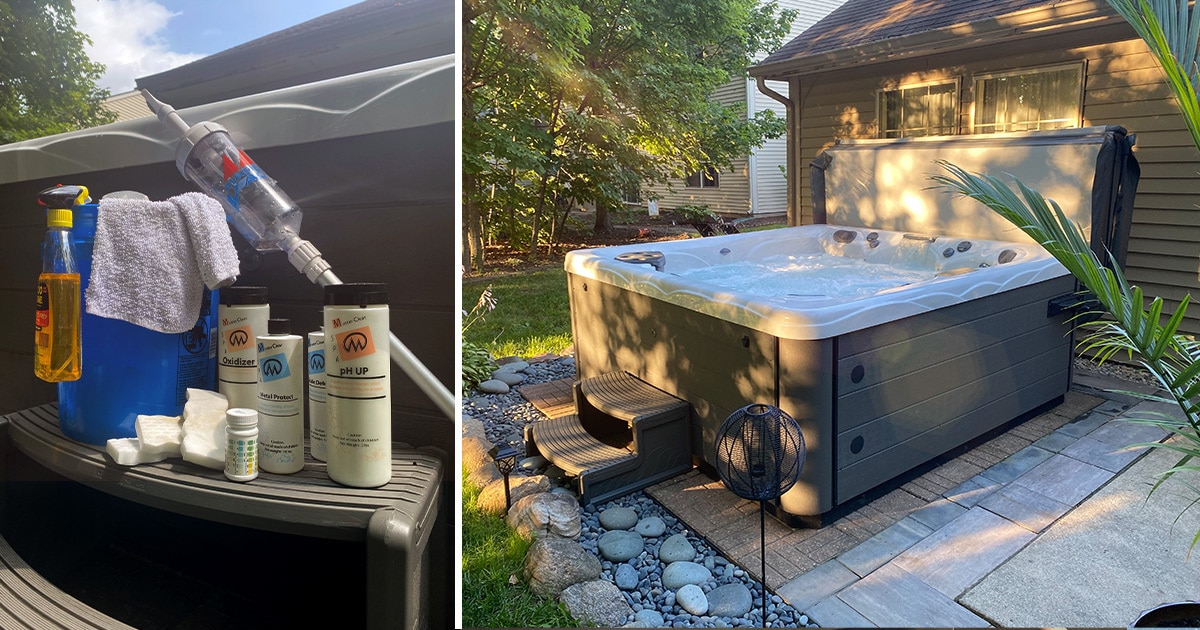
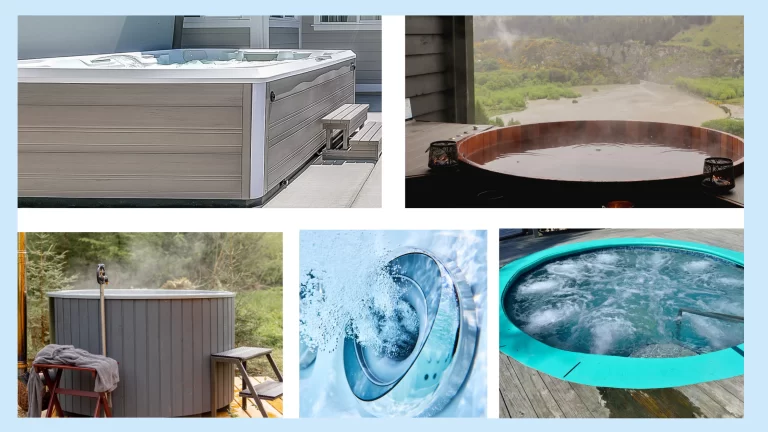
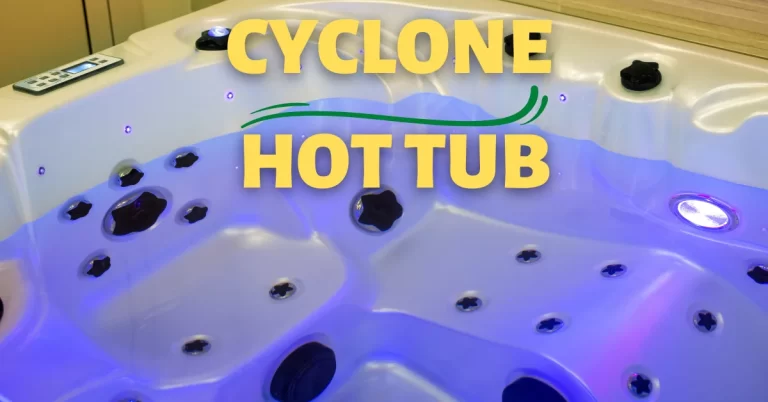

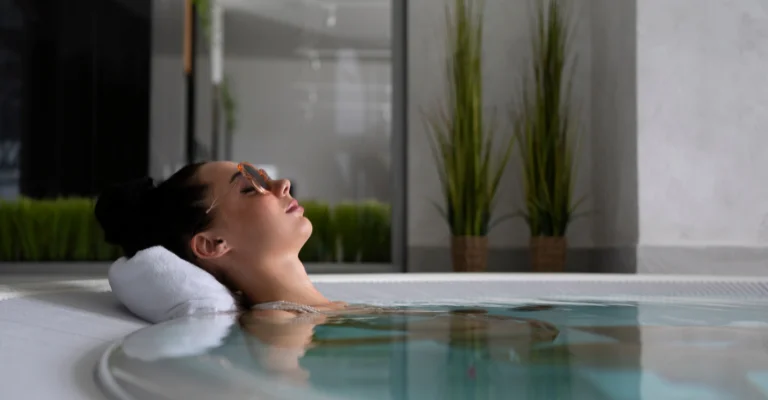
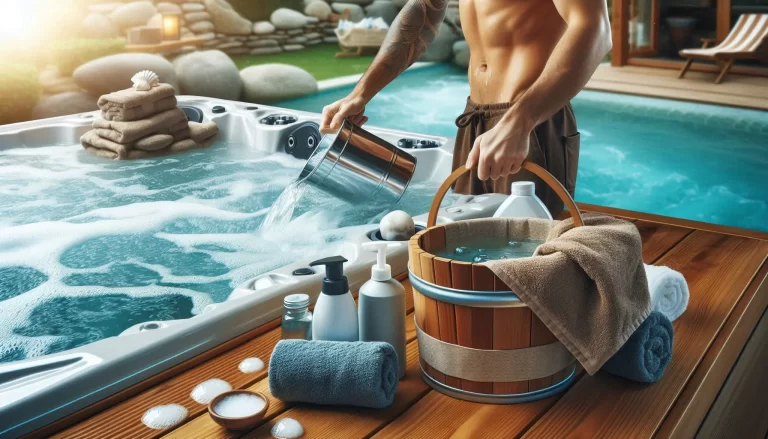
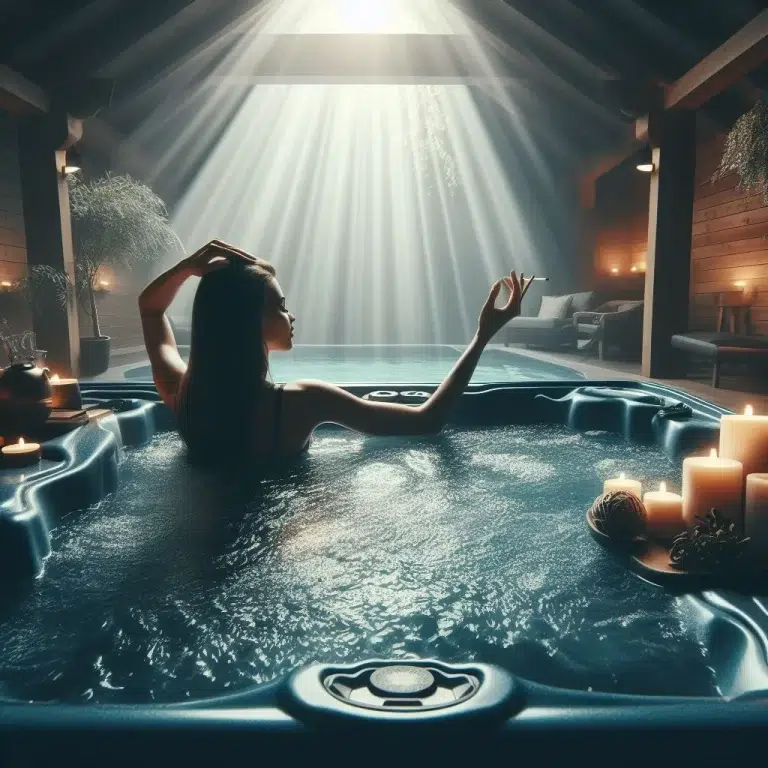
5 Comments